Last week, OpenView Partners, a growth stage venture capital firm in Boston, published a new piece by me entitled “Inbound Marketing Has Passed Its Expiration Date. What Now?” Please check it out.
In the piece I discuss how inbound marketing, one of the dominant marketing approaches of the last 12 years, has become inefficient for most companies. I specifically call out HubSpot and its CEO Brian Halligan who continue to evangelize for inbound like it was 2006 – when it had a lot better chance of working. Inbound has become so inefficient for HubSpot itself that in just five years their customer acquisition cost – the average cost to gain a new customer – has more than doubled.
In doing so, I was hunting elephants: going after a market leader. In his excellent memoir, Behind the Cloud, Salesforce CEO and founder Marc Benioff, describes how they aggressively, publicly, and repeatedly attacked the then-CRM market leader in very creative ways. (If you haven’t read it already, check out the book. It’s a terrific read.) It got them a lot of attention in the trade press and really differentiated them from every other CRM company. Their sales exploded.
In writing that post, of course I wanted (valid) attention. I also wanted to build awareness for my Bullseye Marketing approach which I positioned as a successor to inbound.
I chose to offer it to the OpenView Partners blog because I knew that many area business and marketing thought leaders read their posts (judging from what they had commented on and shared in the past). OpenView may not have a huge national presence, but it could help me build my brand regionally.
And it had that result. People I wanted to reach got in touch with me about the post and shared it with their connections and followers. For example, one local business leader contacted me via Twitter, said “Loved your post on Openview!”, and asked to connect on LinkedIn “for a possible future collaboration.” Sounds good to me.
Don’t be shy, or nibble around the edges. If you’re going to do competitive marketing, go after the big guys. That’s what can get you attention and results.
Part of the premise of Bullseye Marketing is that companies that have been around for a few years have marketing assets, such as email lists and website traffic. But sometimes companies have been so inattentive to their marketing that, even after many years, they may not have these assets. Their website traffic may be very low (and half of that may be bots), and much of their contact list may be out of date.
What do they do then?
From a marketing point of view, companies in that situation are similar to a startup. They can expect that it will take some times to generate significant website traffic, and results from it, and their lists are so small that their email marketing may not produce much in results for some time, either.
They still can focus on understanding their customers better: interviewing them, and working on improving the customer experience. A superior CX is a true competitive advantage. Retaining and growing existing accounts may be even more important than ever.
A customer reference program could be very effective in this situation. The company has customers, the customers like the company’s work, use them to open doors to new accounts.
Focus on direct sales. Choose target accounts and work with marketing on gaining access to them, creating custom content to move the deal forward, and closing them.
Search ads may also be effective since they can get the company in front of people who are in serious search mode for a purchase. These companies may find that purchasing third-party intent date is worthwhile, too.
To make sure that these programs are as effective as possible, you still need to make sure you have your website messaging, calls to action, and conversion experience optimized. Otherwise you’ll be wasting a lot of your effort.
A minimum viable product (MVP) is a key element of the lean startup approach. The idea is that, rather than spending years creating a full product only to find out it’s not really what the market wants, you quickly create a product with enough features to go to market with and get feedback. Then you can iterate and improve on that without risking an all-in failure.
In an interview with WeWork co-founder Miguel KcKelvey for the terrific “How I Built This” podcast, though, we hear that WeWork never had an MVP. They had an idea for the kind of experience that they wanted to provide and they built out their very first space to reflect that. And it was very successful. No doubt over time they’ve added to and refined it, but it was far more than an MVP.
Similarly Tesla never had an MVP – a cheap, economy car that would let them get their toe in the electric car market, and later move up market. The first Tesla was a sporty roadster priced at $109,000. Then they released the Model S sedan which cost around $80,000. The Model 3 was supposed to cost around $35,000, but tricked out as you’d want it it costs more like $50,000-55,000. Instead of starting minimal, they started high end and worked down. (When Japanese car manufacturers entered the U.S. market 60 years ago they started small and inexpensive. Hard though it may be to believe today, there was a time when “Made in Japan” meant, to most Americans, that an item was cheap and poorly made. But the Japanese companies consistently improved their products and today they’re more reliable than most cars from U.S. manufacturers.)
An MVP is a good idea in some markets, like software, but if you’re selling a high end experience or product, you need to deliver that to even your earliest customers. Doing that also establishes yours as a quality brand.
It’s well known that 30 minutes of vigorous exercise five-plus days a week has terrific health benefits. And yet only about 20% of Americans do this.
Similarly, robust marketing programs can have dramatic impacts on a company’s revenue growth. My own study of software companies found that those with broad marketing programs grew about five times faster than those without them. Studies in many other industries have produced similar or greater results.
And yet most companies seriously under-invest in marketing. Again, my study of 351 B2B companies with 50-1000 employees found that while software companies are aggressive marketers, companies in all other industries usually are not. Eighty percent or more of these non-software companies do very little marketing.
Some coaches work on helping world class athletes lower their time by another 1/100th of a second. And that’s fine. But the big opportunity for impacting people and society is getting the 80% of people who aren’t exercising to do so.
And there are marketers, especially those working with large companies with mature marketing programs, who are looking at how to produce constant, incremental improvements. I saw a piece recently from the Boston Consulting Group about how they could improve the sales generated by a large-scale TV campaign by 4% by re-allocating the ad buy. If I was spending tens of millions of dollars on TV ads, I would want that. But few companies are.
My focus, and the audience for Bullseye Marketing (the approach and book) is those 80-plus percent of companies that don’t yet have mature, effective marketing programs in place. That’s where the biggest opportunity is to move the needle and make a transformative difference.
This post was originally published on the Spin Sucks blog.
A few years ago, HubSpot, creators and prime evangelizers for inbound marketing, used the tagline:
If you have more money than brains, use outbound. If you have more brains than money, use inbound.
Since then, they’ve spent hundreds of million dollars on their inbound marketing.
And, as I wrote last year, their customer acquisition costs (the average cost of a new customer) has more than doubled in the last five years.
If your budget is limited (whose isn’t?) and you want cost-effective marketing, use bullseye marketing.
Bullseye marketing is the strategic approach I’ve been developing over the past several years (which I describe in more detail in my new book).
It breaks the launch and scaling of company marketing into three phases, working from the center of the bullseye out:
Phase One: Fully Exploit Your Existing Marketing Assets
Every company that’s been around for a few years has what I call “marketing assets.” But few are taking full advantage of them. These assets include:
- Customers: By talking to customers and listening, rather than always selling to them (or even worse, ignoring them) companies can learn what their customers really want and how to serve and market to them better. Growing existing accounts is also five to 25 times less expensive than closing new ones. But many companies focus too much on new customer acquisition.
- Website: Companies need to have clear and compelling messages on their websites. They also need to have calls-to-action and effective conversion devices. On most websites,99 percent of visitors come and go without the company knowing who they are or what they want. It’s a lot faster and less expensive to double the number of website leads by improving the site than by doubling the number of people coming to the site.
- Email lists: When I talk with SMB prospects I’ll ask “How many email contacts do you have?” They may answer 9,000 or 22,000 or more. Then I ask, “How often do you email them?” And they usually respond, “Oh, at Christmas.” Email marketing is the 500-pound gorilla of digital marketing; consulting firm McKinsey estimates that it is 40 times more effective than social media for customer acquisition. I believe it. You can integrate your email with social media ads by uploading your list to Facebook or LinkedIn. And then you target those ads to those people on those platforms.
- Remarketing: Remarketing ads are those ads you see after you visit a website. For example, you look at a book on Amazon and then start to see ads for it on other sites. They are highly effective because the audience you’re targeting already knows about you and cares enough to have visited your website. They are also usually quite inexpensive.
- Sales and marketing collaboration: In some companies, it takes days if not weeks for good leads to go from marketing to sales. And they may or may not act on them. Companies who cut that time to minutes can dramatically improve sales results.
These programs are inexpensive, and you can implement all of them in a matter of a few weeks or months.
It doesn’t cost much to listen to your customers.
On platforms like MailChimp and Constant Contact, you can repeatedly email a list of 10,000 contacts for less than $100 a month.
And it doesn’t cost much for sales and marketing to start working together better, too.
Not exploiting marketing assets is like putting cash under the mattress rather than in a high-growth stock.
These marketing assets are uniquely valuable because they are yours and yours alone.
When you get into other programs in Phase Two and Phase Three, competitors can bid up the cost of AdWords keywords or make it more difficult for your content to get a high search rank.
But they can’t do anything to prevent you from Phase One success.
Quick wins with Phase One programs also tend to build executive buy-in for the Phase Two and Phase Three programs.
Phase Two: Sell to People Who Want to Buy Now
It’s a big world. And your marketing will be very inefficient (aka expensive) if it’s not focused on people and companies in the market to buy very soon.
Most people start their buying process with research, and that means using search engines.
Properly-targeted Google and Bing search ads are a way to get in front of people seriously considering a purchase.
Of course, there’s more to a successful AdWords program than just keyword targeting.
They also require effective offers, well-written ads, landing pages that deliver on the promise of the ads, and remarketing.
There are other ways to know if someone is in-market, such as a surge in visits to your website and your the other content.
Some third-party companies aggregate and sell the search behavior across the web of people in companies.
So, for example, based on their search behavior they can say people in company X seem to suddenly be interested in a particular product.
Phase Two programs can be turned on quickly, too, and start producing results in weeks.
But they are generally more expensive than Phase One programs.
Phase Three: Cast a Wider Net
In Phase Three, you’ll engage in those long-range branding and awareness programs which include social media, content marketing, display ads (other than retargeting), influencer marketing, events, print ads, and so on.
Unless you’re in an industry where very few competitors are marketing (they exist and they’re a beautiful thing), or you have a very large budget, it may take a few years to get results from these programs.
But the inbound leads they generate tend to close at a high rate.
So in the long run, Phase Three programs can be very valuable.
The irony is, for many people these Phase Three programs are the definition of marketing.
If a company isn’t doing much marketing and decides to try it out, and they start with social media and content marketing, though, after several months they are likely to have very little if anything in return.
Their reaction will probably be, “We knew marketing wouldn’t work for us.”
But marketing can work if you use your brains before your money and apply the Bullseye Marketing approach.
Yesterday it was announced that Adobe would be acquiring marketing automation program (MAP) Marketo for $5 billion. Marketing technology leaders recognize Marketo as the most advanced MAP.
I recently redid my 2014 study of the adoption of digital marketing by 351 B2B companies with roughly 50-1000 employees. This is the heart of the U.S. economy, with hundreds of thousands of companies employing more than three times as many people as enterprises that have 1000+ employees.
When it comes to marketing automation, 74% of the software companies now have a MAP in place, while only 24% of the non-software companies do (companies in such industries as manufacturing, medical devices, and professional services).
And there is a clear distinction between which MAP they preferred. Other software companies (including many marketing software companies) have a growing preference for Marketo. In 2014 the usage among software companies was:
Marketo 39%
Eloqua 25%
HubSpot 29%
Pardot 17%
While the overall usage rate of marketing automation has changed little, the preference for Marketo among other software companies in 2018 is now much stronger:
Marketo 61%
Eloqua 16%
HubSpot 14%
Pardot 9%
For the far more numerous non-software companies, HubSpot is the clear favorite. Their rate of MAP adoption has risen only slightly to 24% in 2018 and the top vendors are:
HubSpot 63%
Marketo 16%
Pardot 14%
Act-On 8%
This reflects a very different approach to marketing and marketing technology between the 85 software companies in my original study and the 266 non-software companies. In 2014 the software companies were using a median of 7 of the 9 digital marketing programs, while the non-software companies were using a median of only 2 of the 9 (and they got one point just for having Google Analytics on their website, whether or not they ever even looked at it). This has changed little in the last four years.
The study also showed the effect on revenue of modern marketing programs. The software companies using 8 or 9 of the programs (such as Google Analytics, marketing automation, search advertising, and social media) were growing almost five times faster than the software companies using 0-3 of the programs; if you’re not using digital marketing today you’re not really marketing.
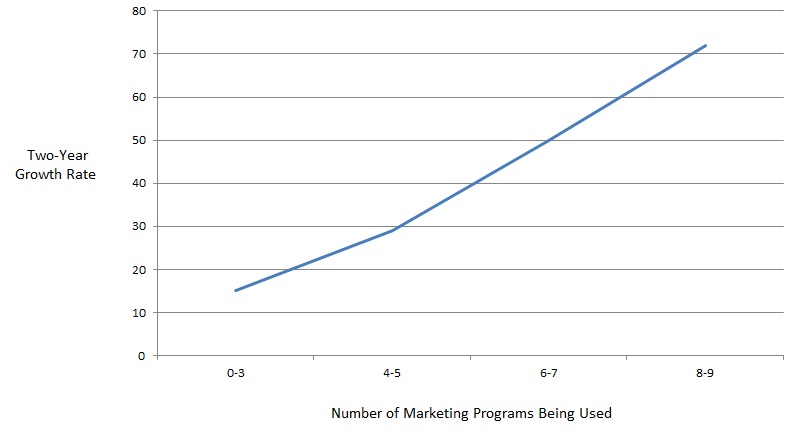
I’ll be releasing more results from this unique study over the next month, but wanted to get this out today because of the news about Marketo.
Would you rather see humpback whales breaching, or a video of it?
Would you rather use Facetime, or have face time?
Would you rather see a Van Gogh, or a virtual reality re-creation?
Almost always, the physical item is superior to the virtual.
As soon as you pick up a physical book, you know a lot about it: is it a coffee table book with beautiful photos? A large reprint of Alice in Wonderland with the original illustrations? A novel? A novella? What is the quality of the materials? How does the paper feel? You have random access and can gain a lot of information quickly. Books in a Kindle or on a tablet are flattened and don’t give up nearly as much on first viewing.
Sales of ebook rose to about 25-30% of total book sales, but they’ve flattened at that level. The rest of the market still prefers physical books.
And physical items (and experiences) are more valuable because they cost more to produce.
Digital is all about convenience. You can carry thousands of songs on your phone, and listen with ear buds, but the quality is not as good as vinyl and great speakers – which is not as good as a live performance.
I heard a talk last week where the person claimed that the essence of customer experience these days is eliminating “friction”, which he seemed to define as eliminating humans.
Then why did Amazon pay $13.7 billion to buy Whole Foods stores?
Why did Apple and Warby Parker open physical stores after they had successful online stores?
Why are Walmart’s thousands of stores considered a major strategic asset, rather than an albatross?
A few years ago I heard the founder of PillPack, the online pharmacy, give a talk. He said that one of their initial discoveries was that seniors didn’t just want their meds packaged up neatly for consumption, they also wanted human support. PillPack couldn’t eliminate phone support; it’s why customers used them. And Amazon recently bought them, too.
It’s definitely more convenient to buy commodities online, and I do it all the time. But I also go to a local green grocer to buy my fruits and vegetables. I want to see what I’m getting, and not just have them show up in a box. I’m not alone; that store is very busy.
Past performance is not indicative of future results. The movement to digital is not inevitable. Use it for the customers who want it, and provide the real thing to those who want that.
Nike Didn't "Just Do It"
A week ago Nike launched the 30th (30!?! – that’s crazy) anniversary of its “Just Do It” campaign with an ad featuring the most controversial athlete in the U.S., Colin Kaepernick.
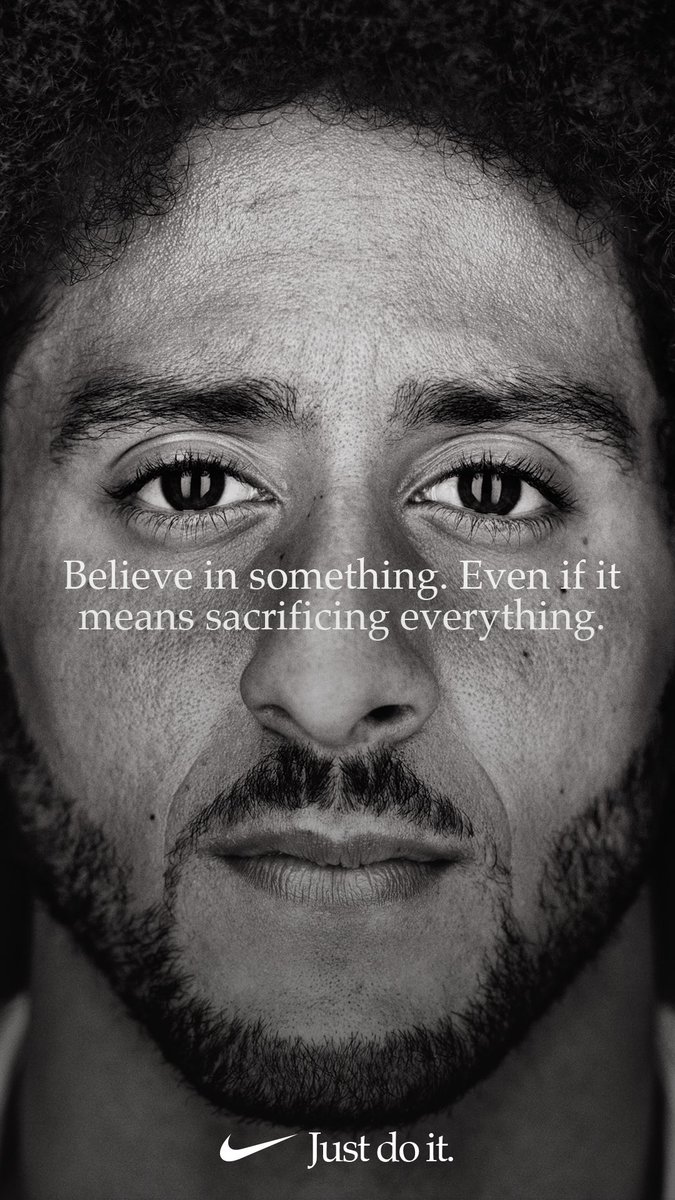
The video version is quite nice.
Kaepernick, of course, is the currently-unemployed NFL quarterback who started kneeling during the national anthem to protest police brutality against people of color. People opposed to the gesture have said that it’s disrespectful to the flag, country, and military, although Kaepernick and others who kneel have said that they are only concerned with police misconduct and not commenting on those.
Nike is considered to be one of the 20 most valuable brands in the world. With revenue of $36 billion last year, it spent over $3 billion on advertising. It’s an extremely sophisticated marketer. It didn’t make this decision lightly.
On social media, mentions of Nike were immediately up 10X while sentiment towards Nike plunged.
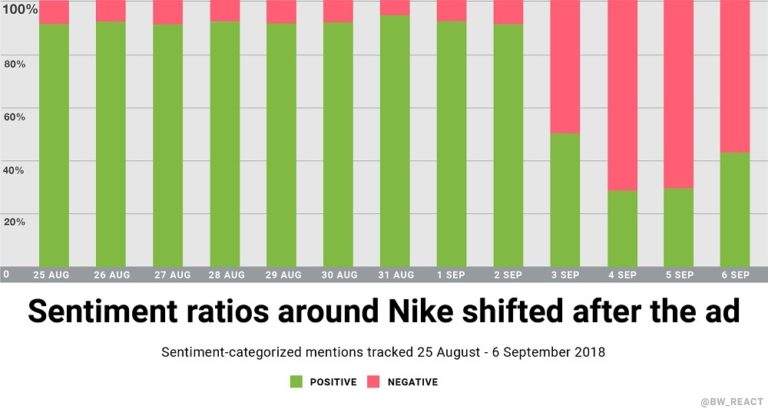
The free media alone was estimated to be worth over $163 million in just a few days. And others found that the sentiment turned positive within a few days.
Brandwatch can only segment its sentiment analysis by gender, and there was little difference between how men and women felt toward the ad. Much more interesting would have been subtabs for age and race. Nike’s customers are largely under 35.
A study of the ad’s impact found that it was strongly positive, and wildly so among Gen Z and Millennials (aka Nike’s market). You think Nike didn’t know that before it made the decision to go with it? Nike didn’t just do this; it built a top 20 brand on research.
Not only does Nike not care if older, white men on Fox News don’t like the ads, it may welcome that. While some called for a boycott of Nike and burned the Nike products that they had previously bought, Nike sales were up 31 percent.
Shares of Nike stock dropped a few dollars after the announcement of the ad, but rebounded recently upon news of the sales uptick.
People are increasingly comfortable with brands standing for something, and possibly even demanding it. Nike previously has taken positions on AIDS, gender inequality, disabilities, and religion (with its Pro Hijab); not only their customers but their athlete endorsers demand it.
Not Inbound, Not Outbound, but Bullseye Marketing
The inbound versus outbound marketing dichotomy is becoming tired, and increasingly useless. We need a new approach to demand generation, and building leads and sales. I call that new approach Bullseye Marketing, which I describe below.
But, first, what’s wrong with inbound and outbound?
For inbound, let’s look at HubSpot itself as an example. HubSpot co-founder and CEO Brian Halligan created inbound marketing about a dozen years ago as a variation of Seth Godin’s permission marketing. Inbound is so closely identified with HubSpot that the company’s annual conference is called “Inbound”, and they talk of the “inbound movement”.
Inbound marketing aims to attract people to a company or product through useful or entertaining content – rather than “interrupting” their online experience with outbound ads – and to then nurture the relationship with emails and additional content that the customer has agreed to receive. Marketers with deep inbound experience will tell you that the leads produced with inbound usually close at a higher rate than outbound leads.
In its early days, HubSpot used to say, “If you have more money than brains, use outbound marketing. If you have more brains than money, use inbound marketing.” But that was before HubSpot spent hundreds of millions of dollars on their own increasingly-inefficient inbound marketing. How can we measure that in inefficiency?
In 2014, HubSpot wrote in its annual report, “We believe that that customer acquisition cost, or CAC, is an indicator of the efficiency of our sales and marketing programs in acquiring new customers.” But, as I wrote last year, in just a few years the HubSpot customer acquisition cost – or the average cost of a new customer –has more than doubled.
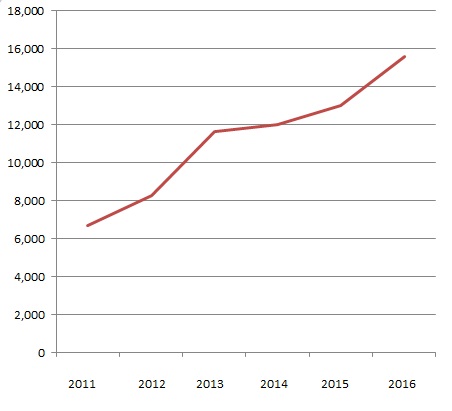
In 2017, HubSpot spent $212M out of a $340M budget — over 60% — on sales and marketing. That’s a MUCH higher percentage than most companies spend, could spend, or have to spend. And, relying mostly on inbound leads, HubSpot needs 300-400 new contacts to close a single new customer. That’s not unusual for large, inbound programs, but few small- and midsized companies are prepared for or willing to do that.
Why has inbound become so inefficient?
A major reason is because search engine marketing has become virtually winner-take-all.
It’s well known that the majority of organic search clicks happen on the first three links on Google page one search results. But it’s not always understood just how hard it’s become, in most industries, to achieve those lofty rankings.
Ahrefs reported last year that only five percent of new content even makes it to page one search results in Google within a year, let alone into one of the top three positions. It typically takes two to three years for a post to rise to a top position.
And the top links usually belong to sites with considerable domain authority.
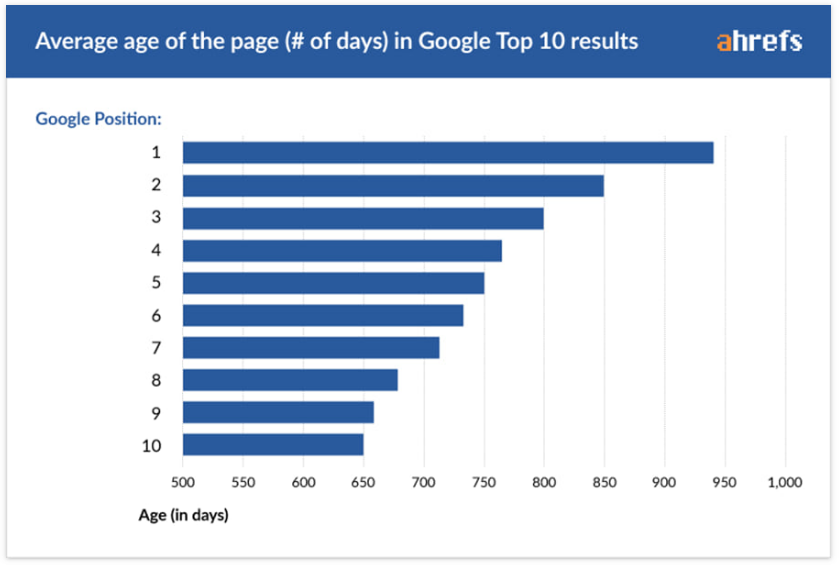
Moz founder and SEO expert Rand Fishkin wrote earlier this month that “the future of SEO has never been clearer (nor more ignored)”. One of his six key points was “Less opportunities for small sites and emerging companies as a few big players dominate an ever-increasing share of Google’s top results.”
And the rise of voice search, which delivers one result, just accelerates this trend
So unless you’re in one of those few industries in which very, very little content has been produced, the idea that you’ll create a few blog posts, videos, or infographics, get them high on page one search results, and generate meaningful traffic that produces lots of inbound leads, is simply outdated. You have to become a content factory to produce meaningful results – something that HubSpot did but it cost them, and continues to cost them, huge sums.
Inbound may be increasingly inefficient, but outbound marketing has always been inefficient. Primary tactics include advertising, direct mail, spam emails that a person has not asked to receive, and telesales.
Click-through rates on online ads are about .05%. Do Not Call lists and caller ID make it harder and harder to reach customers by phone – and they’re rarely happy to get the call if you do get through. Perhaps one or two percent of cold calls result in a meeting or sale. And so on: you know the drill.
And the inbound/outbound dichotomy is increasingly useless. Once released from their obligation to promote the inbound approach, even former HubSpot executives will tell you that companies need to use both.
So if inbound and outbound are both becoming increasingly inefficient – and the dichotomy is increasingly irrelevant — what’s the alternative?
Bullseye Marketing
Bullseye Marketing is the low-risk, low-cost, three-phase approach that companies can use to launch and scale successful marketing programs that actually drive business results.
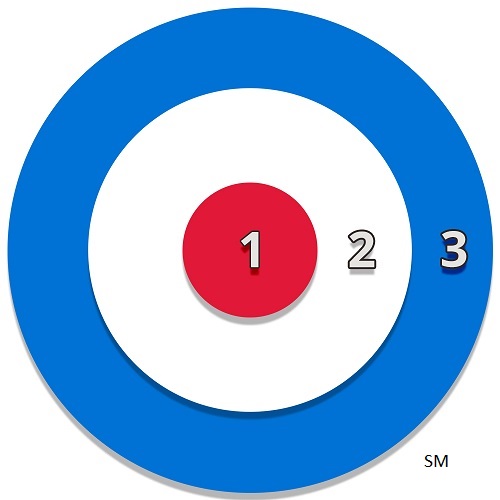
Phase 1: Fully Exploit Your Existing Marketing Assets
Most companies that have been around for a few years have considerable marketing assets, but they are rarely aware of them or taking full advantage of them. These assets, and how to exploit them, include:
Customers
- Gain a better understanding of customers and their needs through listening conversations so that you’re offering them the best products and services and your marketing activities can be as effective as possible.
- Market and sell more to your existing customers. It’s estimated that it’s five to 25 times more expensive to close a new account than to retain and grow an existing one, yet in many companies a much greater emphasis is put on closing new accounts.
Website
- On most websites 99.9% of visitors come and go without anyone knowing who they are or what they are interested in. With Bullseye Marketing you sharpen your message and provide calls to actions to induce visitors to start to interact with your company.
- You also improve your conversion rates so more website visitors take advantage of those calls to action. It’s a lot faster and cheaper to double the rate of conversions from people already coming to a website than to double the number of visitors.
- Email marketing is the 800-pound gorilla of digital marketing. Consulting firm McKinsey & Company estimates that email marketing is 40 times more effective for customer acquisition than Facebook and Twitter. And marketers routinely describe it as the digital channel with the highest ROI. Bullseye marketers don’t buy lists or spam people; we grow and use a house list to provide useful information that contacts, prospects, and customers value. (BTW, that McKinsey piece is from 2014 but, if anything, things have gotten worse for brands on social media since then because the platforms increasingly suppress the posts of brands. Five years ago a brand’s posts on Facebook or Twitter may have been seen by 25% or so of their followers; today it’s more like two percent. These platforms want you to pay to show their posts.)
Remarketing
- Remarketing ads are those ads that follow you around the Internet after you’ve looked at a website. Love them or hate them, remarketing is inexpensive and effective because you’re only targeting people who have enough interest in you to have recently visited your website.
The Sales Team
- In Bullseye Marketing you put a premium on working more closely with sales to better understand customers, grow current accounts, generate leads, and close new accounts.
- Account based marketing (or, as it’s sometimes called, target account marketing) is an important Bullseye tactic that requires very close collaboration between marketing and sales.
These Phase 1 Bullseye Marketing Programs can typically start producing results in just a few weeks or months. Except for staff and management time they are very inexpensive – usually free – and so very low risk. They provide a path to quick wins that can build the internal buy-in for Phase 2 and 3 programs.
And they’re foundational: a company that jumps to Phase 2 and 3 programs without first getting Phase 1 right is trying to fill a bucket that’s full of holes.
Phase 2: Sell to People Who Want to Buy Now
A person who just bought a car is unlikely to buy another for several years, just as a company that just had its website redone probably won’t do it again for another four years or so. On the other hand, people buy groceries every week and clothes many times a year.
Targeting your marketing to customers who are in-market now is critical to marketing efficiency and success.
- Search ads are one way to do this. The vast majority of people, whether shopping for themselves or for the company that they work at, search early in their buying process. By initially focusing on the keyword phrases that suggest strong buying intent, marketers can hone in on those most likely to buy soon.
- A surge of people from a company visiting a vendor’s website, reading the vendor’s emails, and downloading their content suggests much stronger buying intent at that company; marketing and sales should target and follow up with them.
- Some third-party vendors aggregate search data from many websites to identify the companies that are in market for particular products now and sell that list to vendors.
All of these are ways of taking advantage of intent data to identify people and companies that are in market now and then hyper focus your sales and marketing on closing that new business.
Phase 3: Cast a Wider Net
In the outer ring of Bullseye Marketing we use programs like social media, content marketing, and display ads to build our brand and awareness. In the long run these can contribute greatly to the success of our marketing programs, but they are unlikely to produce measurable results for the first year or two (unless done as part of a large scale, very expensive program). So they are, initially, a low priority.
These long-term programs can ultimately have great value. Companies with strong brands elicit greater brand loyalty. They generate inbound leads, and customers are often willing to pay more (like $1,000 for a phone). But they are not the place to start.
Unfortunately, programs like social media and content marketing are virtually the definition of “marketing” in many people’s minds. So companies new to marketing may begin with these programs, see no results and, after six months or so say, “We knew marketing doesn’t work for us” and stop.
But it could work, if they used the Bullseye Marketing approach.
Clearly, companies that already have a large, omni channel marketing program in place don’t need Bullseye Marketing. But for the 80-plus percent of companies that don’t have that, Bullseye Marketing provides a low-risk on-ramp to faster business growth.
I provide a much-deeper dive on Bullseye Marketing – with hundreds of tips, best practices, and full-color examples — in my book of that name that you can buy on Amazon.
My Bullseye Marketing book is now available on Amazon. Setting up the Kindle and paperback versions was a fascinating look into Amazon’s pricing algorithms.
When I setup the ebook version they gave me two pricing options:
- I would get 70% of the sale price but could only charge between $2.99 to $9.99, and they’d charge an additional fee per GB for the download (because their bandwidth is so expensive?), or
- I would get 35% of the sale price and could charge whatever I wanted up to $200.
They also had a chart showing what their data showed them was the best price for my book based on “similar” books: $5.99.
Frankly, I didn’t think that their algorithm could take into account quality or branding. Just as a matter of quantity, how many 350+ page marketing books with over 100 full-color images did they have? Not many. And even fewer with some of the features of Bullseye Marketing, such as the interviews with eight industry experts and the long piece by MailChimp’s CEO Ben Chestnut on how to write a great email. And in terms of branding, IMHO a price of $5.99 (of which I’d get $2.09) just smacked of a low quality title. So I chose Door #2 and priced the ebook at $16.95.
Then when I setup the paperback version the fun really started. For bookstores I’ve set a suggested retail price of $39.95 per copy, of which I get less than $6. But when I got to Amazon’s paperback pricing page they said that their printing cost is $27.45 per copy – roughly double what I pay my other very high quality print on demand vendor servicing bookstores – and so the minimum I could charge on their site is $45, of which I would get $.01!
I think that the printing fee, minimum price and the split are ridiculous, but Amazon owns 85% of the ebook market and over 50% of the physical book market. For me to get anything I had to set the price higher than $45 (and they would get half of the addition amount). I very reluctantly set it at $59.95 (“You think your book is plated with gold?”) and Amazon will get more than five out of every six dollars.
When I thought about it, I figured that within a few days they would probably set a special “discounted” price for Prime members. As my father used to say about items on sale, “Mark it up to mark it down.”
What surprised me was when I noticed a couple days later that Amazon listed “2 new from $41.34”. Who else was selling it so fast?

It turns out that a company called PBShop US is – at much closer to the proper price (with free but slow shipping). My assumption is that they’re a kind of book arbitrageur: their computers see when Amazon lists a new book, checks for other printers where they can order it and the price, sees what Amazon’s markup is, and if they can get it cheap enough elsewhere they offer it for sale. They have apparently automated this since they have a 97% satisfaction rating from close to 500,000 reviews.

Jeff Bezos may say things like, “We see our customers as invited guests to a party, and we are the hosts. It’s our job every day to make every important aspect of the customer experience a little bit better”, but you can usually get a better price on Amazon for the identical item if you’re willing to move your eyes a few inches, or make one more click.
I’m still investigating alternatives to get the online price down to the bookstore $39.95. Most people who come to Amazon will see that big $59.95 price that I hate. Maybe Amazon will knock it down in a few days as I speculated/hoped.
But if you want to get the paperback for $39.95, you can go into your local bookstore and order it. They may even discount it a bit from the MSRP.
If you want to get 25% off of the paperback price, host me to speak to your conference or group. I’ll bring copies to sell for only $29.95.
And that $16.95 ebook looks better and better.
